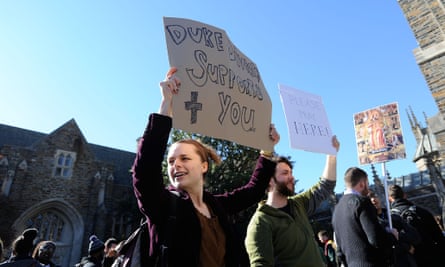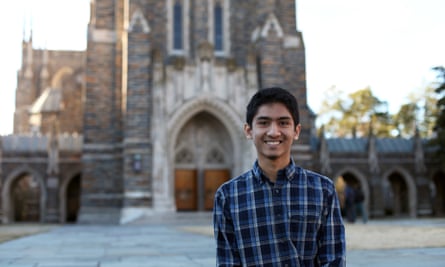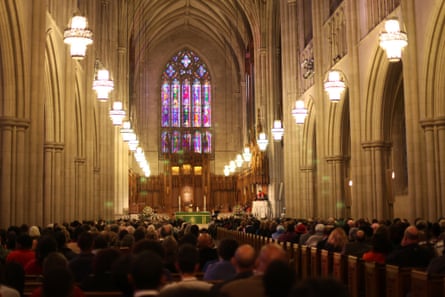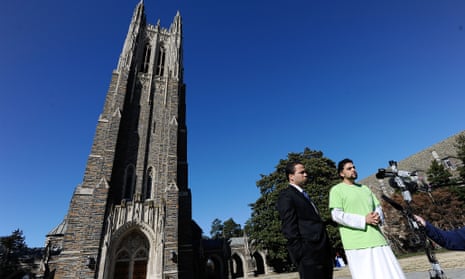There were dozens of people inside the Center for Muslim Life on Duke’s campus Sunday night, but when the university’s president, Richard Brodhead, walked in, suddenly all was quiet.
After a few hesitant initial steps, though, Brodhead found himself swarmed by students, eager to speak and have their pictures taken with him.
Despite the excited melee, not all students were pleased at Brodhead’s surprise visit to the Muslim Students Association’s open house event. It had been, as Rev Luke Powery, the Dean of Duke Chapel, rightly observed, a “stressful and painful week” for the university’s Muslim community, and the administration that Brodhead leads had been a major part of that when it decided to disallow Muslim students from reciting a call to prayer from the school chapel’s historic bell tower.
On Wednesday, Duke Chapel staff announced that it had invited the university’s Muslim community to recite the call to prayer from the bell tower on Fridays, a plan that had been in the works since last semester. But after mounting discord both inside and outside the Duke community, and reports of threats, the recitation was moved to the front steps of the chapel. The call to prayer is due to be recited once more on the steps of the chapel on Friday.
Brodhead told the Guardian that he had come to “pay his respects to his students”, but many students at the gathering, both members of the MSA and not, were still reeling from confusion and disappointment over the decision and the hostile environment to which they had been subjected during the controversy over the call to prayer.

“It definitely hurt,” said Noura El-Sayed, a Duke undergraduate student and active member of the MSA, a sentiment echoed by many in the MSA. “But we just wanted to hang out and have some light-hearted conversation after everything that’s happened,” added Umer Ahmed, an undergraduate student from Chapel Hill and member of the MSA.
The call to prayer, or Adhan, is a short verse recited to summon Muslims to mosque, typically amplified with a microphone from the minaret, or tower, atop a mosque. It is normally said five times per day, but at Duke it would have been only once a week, on Fridays.
It is thought that the Adhan has never before been broadcast on a non-Muslim US college campus, though Emory University had a recitation of it during its 2010 Islam Awareness month. You might hear a call to prayer at Zaytuna College, the first Muslim liberal arts college in the US, “but it is an informal thing that students do if they feel like it,” saidSafir Ahmed, the college’s director of marketing and communications. There is no mosque on campus, and no amplification of the Adhan.
Conceived by Christy Lohr Sapp, the associate dean for religious life at the chapel, the call to prayer was intended to be an opportunity to reinforce the “commitment to religious pluralism that is at the heart of Duke’s mission”, Sapp wrote in the Raleigh News & Observer.
But what some saw as a small token of welcome and an opportunity to challenge “media stereotypes of Muslims”, others took as an affront. The questions that were raised by the call to prayer, addressing topics like the state of Muslim identity within American public spaces and the nature of Duke’s religious pluralism, caused a national firestorm no one at the university could have predicted and left behind a community divided along multiple fault lines.
The chapel occupies a position of import at Duke, metaphysically and otherwise. Built as a central symbol, it was the last addition to Duke’s gothic West campus, completed in 1932. Today, it is one of the most recognizable symbols of the university, the part of campus that those watching Duke basketball are most likely to see in gauzy packages on TV.
Muslim students have been allowed to pray in the chapel’s basement for roughly twenty years, reciting the call to prayer informally in the basement before Friday prayers began. A bell tower Adhan would have been a new step for the Muslim community, and for Duke.
“I was surprised that someone outside the MSA would even propose the Adhan,” said Umer Ahmed.

“It was different than us bringing it up ourselves,” said Aamir Azhar. “We wouldn’t want to do something like that because we were afraid about the kind of opposition we would run into.” But when the plan came together, he said, “we were really happy to have it.”
But after the plan to broadcast the Adhan was announced publicly last Tuesday, there was an almost immediate backlash.
Franklin Graham, the son of Billy Graham, arguably North Carolina’s most influential pastor, was a chief driver of it, writing a Facebook post denouncing the chapel’s decision and calling on donors to “withhold their support from Duke until this policy is reversed”.
After that, the controversy escalated quickly and dramatically enough that the Center for Muslim Life soon received threatening phone calls, enough to frighten the students.
“I like to think of myself as tough, but even I was scared on Thursday,” MSA member Noura El-Sayed said, expressing a sentiment several other students who spoke with the Guardian shared.
On Friday, the university put its decision to move the call to prayer down to unspecified “security concerns”, which Michael Schoenfeld, the vice-president for public affairs at Duke, declined to further elaborate on when reached by the Guardian.
But some at Duke are wondering whether threats were used as a pretext in order to avoid a much larger issue.
“We never got an explanation from the administration,” said El-Sayed, “at least not one that is satisfactory.” Though she said she understands the decision made by the university, in light of the backlash, “it felt like we as a community weren’t worth fighting for.”
“The threats were certainly real,” said Omid Safi, the director of Islamic studies at Duke. “But the question is whether the university should be using those [threats] to avoid dealing with the other, more complicated issues.”
These complicated issues center around the question of religious pluralism at Duke. Though today Duke is nominally secular, the university was founded as a Methodist school, and there is still vociferous debate on campus and off about Duke’s identity as a “religious institution”.
At least 65% of American Muslims are first-generation immigrants (pdf). A majority of Americans who identify as Muslim consider religion to be a “very important” part of their lives. On top of that, a large number of international students from Muslim countries are being recruited to US institutions. So now, according to some reports, the number of Muslim students in US colleges has doubled over the past 15 years. As a result, universities – and not just ones like Duke that emerged from a Christian tradition – must grapple with a microcosm of the questions that the US as a whole must address. Muslims have been immigrating to America in significant numbers since the 1960s, but in a post-9/11 America, where do they fit into its society? And are Americans – Muslim and non-Muslim – willing to accept that freedom of religion means what it says, for everyone?
Of Duke’s 15,000 students, roughly 700 people identify as Muslim, and about 70 attend weekly Friday prayers, according to Duke’s Muslim chaplain, Imam Adeel Zeb.
“In 1988, there were two undergrads and 15 or 16 grad students,” said Safi, who was a co-founder of the Duke MSA when he was an undergraduate. “We were first allowed to pray in the chapel crypt, and we did that for a number of years. We wanted a place to pray, and people prayed in the chapel, so it made sense to pray in the chapel … that’s what was available.

“When I came here in 1970, this was still a very protestant institution, which broadened to include Catholics, Baptists, Episcopalians, Jews – but Islam has been a latecomer,” said Dr Bruce Lawrence, who has taught at Duke for more than 40 years and has been part of diversification efforts. In the past 10 years alone, Duke has gone from having one part-time imam to a Center for Muslim Life, an imam and a Muslim chaplain.
Though there are no definitive numbers tracking the growth of the Muslim population in US colleges, several universities – including traditionally Christian colleges – have noted an uptick in Muslim students. In April, the University of San Francisco will host a conference on Islam’s presence within Jesuit and US colleges at large, due to the “growing number of Muslim students and faculty on our campuses”. Yale’s Muslim chaplain, Omer Bejwa, has also seen a growth in the Muslim community there.
The clear diversification of faiths on campus over the past 40 years has led to a reassessment of the structure of religious life at Duke, as evidenced by the Divinity School and the chapel’s radically divergent attitudes to the Adhan. The idea for the call to prayer came from within the chapel, which represents all religious groups on campus, while the Divinity School, whose chief concerns remain of, by and for Methodists, opposed it. “These institutions are simply in opposition to each other,” Lawrence said.
Despite the increased diversity, Duke’s Muslim population has been made to feel like “second-class citizens” over the past week, according to the Muslim chaplain, Imam Zeb.

Richard Hays, the dean of the Divinity School, wrote a three-page letter last Friday in light of the university’s decision to backtrack on the plan for the Adhan. In the letter, Hays said that he was not consulted by the chapel staff on the plan and that there are “serious questions about the wisdom and propriety” of allowing the Adhan from the chapel tower, as the chapel “maintains an explicit Christian identity and mission”; he argued that “Christianity and Islam stand in significant theological tension with one another,” and that there would be “global repercussions” to allowing the Adhan to be broadcast from the chapel tower.
Several members of Duke’s community disagree, including Lohr Sapp, whose idea the call to prayer was. For her – and, she says, for the chapel community – “we are a space where Christian worship happens every day (if you count weddings), but we are also a university space and a space for secular events.”
Duke Chapel is not owned and run by a church, but by the university, and its dean is a Duke employee. In addition to the Muslim prayer sessions in the basements that have gone on for years, it has hosted other non-Methodist religious observances, including Hindu and Buddhist meditation sessions and a Hannukah song that was played from the tower in 2011.
“There are many ways Christianity and Islam are tied,” Lawrence said. “The tensions are cultural and historical, though, not theological … The theological tensions are generated by the division of authority – not between Muslims and Christians or between their sacred texts and doctrinal creeds – but between the Duke Divinity School and the religious life staff of Duke Chapel.”
Hays declined to comment on his letter.
Despite the collective sense of disappointment that the Adhan did not come from the chapel bell tower, roughly 400 people showed up at the chapel steps last Friday to hear the Adhan there. “The outpouring of support on Friday was touching and beautiful,” Lohr Sapp said, though she said she found it difficult to watch the Muslim students’ disappointment.
Members of the MSA did note a silver lining to the controversy. It wasn’t just Muslim students who came to the Adhan on Friday; Divinity School students came, too, with messages of support, as did several other non-Muslim students. “To have [the Divinity School] embrace us Muslim students in a potentially unsafe environment was really touching,” said Umer Ahmed.
“I’m hoping something constructive will come out of this, because I’m frustrated that there isn’t enough dialogue happening,” said Aamir Azhar, the freshman. “It’s much easier to attack a group of people than an individual, and it’s even easier to attack an idea than a group of people.” But, he said, he believed it was an issue of education being needed, not of hate. “So there’s hope, I guess.”

Comments (…)
Sign in or create your Guardian account to join the discussion